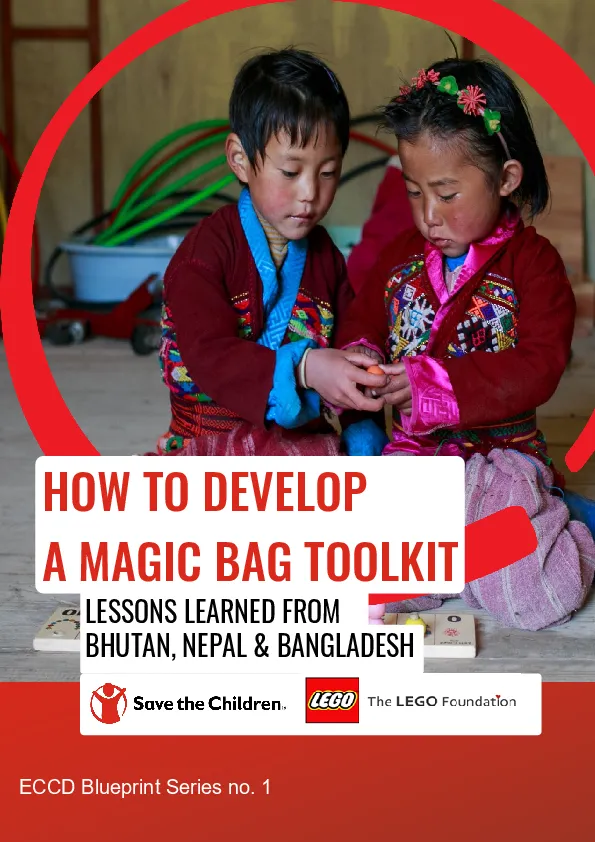The Magic Bag Toolkit
Share:
Magic Bags are a collection of toys, books and other play resources, originally used to promote distanced playful parenting to children aged 0-5 during the COVID-19 pandemic in Nepal, Bhutan and Bangladesh. Now, this Magic Bag Toolkit is a how-to guide for stakeholders, ECCD practitioners and program teams interested in adopting the approach and improving at-home learning and playful parenting for the youngest children who need it most. The need for low-contact interventions that promote playful learning for the youngest children remains high, especially in light of the continued impact of COVID-19, climate change and other stressors that threaten the continuity of learning. This project was implemented as part of the LEGO Foundation’s COVID-19 response, which supports the children most in need and ensures that they continue to have access to learning through play, helping to develop life-long skills.
Photo: (c) Save the Children
Want to create your own magic bag? To help you get started, our toolkit is divided into three main components:
-
Magic Bag Materials: Learn how to choose the materials in the Magic Bag according to the age-range and developmental needs, as well as guidance and examples of Magic Bag Books, a guide that accompanies the bag and supports caregivers to play with their children at home using the materials.
-
Videos: All three teams also developed accompanying videos to support the Magic Bag intervention. The Toolkit provides examples of the videos they produced, as well as practical guidance to guide teams wishing to create their own accessible magic bag videos that demonstrate playful parenting practices, promote toy-making, and demonstrate story-telling.
-
Radio: In Nepal, a recorded radio program provided additional guidance on how to use the Magic Bag materials and suggested different ways to engage children in playful learning activities at home. This Toolkit provides additional guidance and examples of how to develop an accessible Magic Bag radio program.
All three case countries designed their magic bags based on the age-range of the children targeted and the particular needs of communities most affected by COVID-19. All three countries also included videos, although the style of the videos varied, with Bangladesh and Nepal creating story-telling videos based on books included in the bags as encouraging at-home reading was a central focus of their bags, while the Bhutan team created how-to videos guiding caregivers on how to use the materials if their children in guided activities. The Nepal team also added in a radio component, as they had previous success using radio to reach distanced communities, whereas this technique was not used in the other countries due to low perceived listenership.
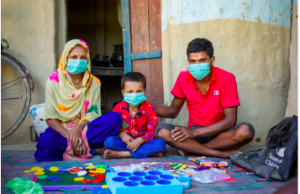
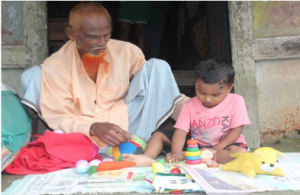
Save the Children Nepal & Bangladesh
Magic Bag Materials
The Magic Bags are not static: the materials included can and should be adjusted according to the needs of children, availability of materials and supplies, and the developmental domains to be strengthened. Selecting the materials to include in the Magic Bag is one of the first steps each team must go through when starting a Magic Bag project. Below are two categories of resources to help you get started: 1. the Magic Bag Wishlist, which includes a list of materials tagged by age, developmental area, and with comments on necessity and cost-efficiency, to help teams design their bags, 2. the Magic Bag Guide, which is a printed book or document that goes along with each Magic Bag to help caregivers use the materials with their children. For more information on how the bags were designed, developed and distributed in the case countries, as well as tips from implementors, please see the Magic Bag Toolkit.
Magic Bag Wishlist (Selecting the Items to Include in your Magic Bag)
2 resources
Magic Bag Guide (Creating a reference booklet for caregivers and children)
1 resource
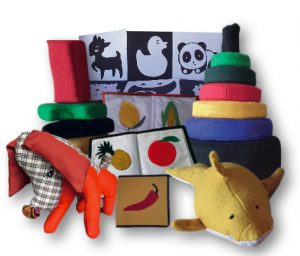
Magic Bag Videos
In all three case countries, videos were also developed to support the use of the magic bags. This provided a supplementary guidance for caregivers, especially those with low literacy who might not benefit from the printed guides. Here you can find links to all the videos created by the Magic Bag teams. Looking for more? Recommendations and implementation guidance on creating and rolling-out videos can be found in the Magic Bag Toolkit.
Magic Bag How-To Videos (Bhutan)
4 resources
Storytelling Videos (Designed to Accompany the Books Provided in the Magic Bags- Nepal & Bangladesh)
16 resources
Magic Bag Toy-Making Videos (Bangladesh)
10 resources
Magic Bag Radio
This section of the toolkit provides resources on how to create and use radio programs to accompany the Magic Bags. This approach was only tested in Nepal, as the team had considerable experience developing 'mini-series' and there was high-listenership in targeted areas. For more information on how the radio programs were designed and developed, as well as recommendations from the Nepal team, please read the Magic Bag Toolkit.
Radio Resources
1 resource
Frequently Asked Questions
-
Are the materials in the Magic Bag standard everywhere? No! The Magic Bag materials can and should be different depending on the needs and age of the children who will receive the bag. For example, if you have recently done an assessment of developmental milestones and have noted that children in the target group are delayed in their physical development, you may choose to include more materials that promote fine and gross motor skills in your bags. The Magic Bag Wishlist designed to be a starting point for teams who are selecting what play and reading materials to include in their magic bags. Although this list is not exhaustive, it does include a wide variety of items to be used. Teams looking to implement the magic bag approach can use this list to help them select and narrow down their play and reading materials according to the needs in their context.
-
Are these materials available in other languages? At the moment, the toolkit is available in English. Some of the resources in the toolkit are available in Dzongkha, Nepali, and Bengali as well. As more teams use the Magic Bag approach, we hope to add new languages, resources, and feedback from users.
-
I want to create a magic bag at home for my child- how do I get started? The first step is to review the Magic Bag Materials. You can narrow your search by age range to help you get started. Take a look through the materials and select which ones would work best for your child’s age and development. Not able to find the materials near you? Don’t worry! You can watch these videos from the Bangladesh team on how to make different toys, or use the resources in the Materials list to link you to how-to videos and websites.
-
I want to use magic bags in my ECCD program- how do I get started? Please take a look at our toolkit to get you started and learn from the experiences of the case countries. We’d be happy to discuss with you and find ways to support your magic bag journey– and learn from you as well as you develop and use the bags! You can contact the Magic Bag Focal person, Shahin Islam, at shahin.islam@savethechildren.org.
-
I have another question, feedback, or resource to add. What can I do? If you are a part of the Save the Children Movement, the best way to reach out is through the ECCD Champions Workplace Group.
By the numbers
Throughout the program implementation period, over 36,173 children and caregivers were reached directly through the interventions, with another 70,406 reach indirectly. The reach breakdown is provided in Table 1 below.
| Table 1: Reach by Country | ||||
| Number of Children Reached | Number of Caregivers Reached | |||
| Direct | Indirect | Direct | Indirect | |
| Bangladesh | 12,000 | 17,143 | 4,286 | 21,428 |
| Bhutan | 5,341[1] | 1,006 | ||
| Nepal | 8,525 | 13,544 | 8,742 | 18,291 |
In addition to the reach numbers included above and compiled in each country, the Bangladesh team also conducted an assessment to test the effectiveness of the intervention. The assessment followed a quantitative research design and involved a pre-intervention survey conducted in February-March 2021, which was followed by a survey in September-October 2021, after the distribution of the magic bags. The more than 750 caregivers and their children were assessed in the pre and post assessment, chosen randomly among the 12,000 child recipients of the bags.
During the post-assessment, 100% of caregivers reported that their child uses toys and play materials in day-to-day play. Specifically, 90% of caregivers reported their child is using books or reading materials, compared to just 64% prior to the intervention. There was an eight percentage point increase in children aged 0-3’s ability to say one or more word, and 75% of children aged 3-5 felt that they could share their feelings with their caregivers, compared to just 51% prior to the intervention.
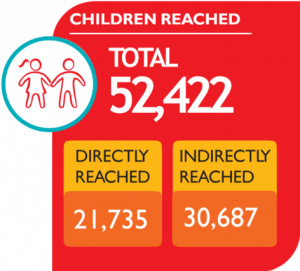
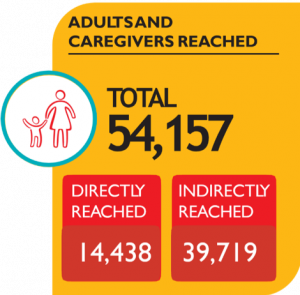
Share
Link

